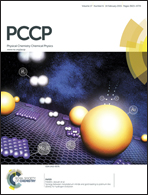Spectroscopic study of ionic liquid adsorption from solution onto gold
Abstract
Gold was exposed to ethanol solutions containing 0.1 wt% 1-hexyl-3-methyl-imidazolium bis(trifluoromethanesulfonyl)imide (HMIM NTf2), an ionic liquid (IL). The resulting adsorbed layers were interrogated using X-ray photoelectron spectroscopy (XPS – both conventional and synchrotron-based) and spectroscopic ellipsometry. Ellipsometry indicated that the adsorbed layer thickness was smaller than the size of an IL ion pair, with an average determined layer thickness of 0.15 nm. This value indicates that the adsorbed layer on gold is most likely patchy. Conventional XPS revealed that the IL adsorbs irreversibly to gold, with equal amounts of anion and cation in the adsorbed layer. High signal-to-noise synchrotron XPS spectra permitted detailed deconvolution of the S 2p and N 1s peaks for the IL-treated gold, providing more information on adsorbed layer composition and structure. Spectra acquired as a function of X-ray exposure time indicate that non-interacting physisorbed IL components are preferentially removed at the expense of surface bound components, and that anion and cation are both present in the surface bound layer, and also in the layer above. A model structure for the IL adsorbed on gold is proposed.


 Please wait while we load your content...
Please wait while we load your content...